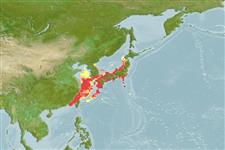sub class Elasmobranchii (ฉลามและกระเบน) (sharks and rays) >
Heterodontiformes (Bullhead and horn sharks) >
Heterodontidae (Bullhead, horn, or Port Jackson sharks)
Etymology: Heterodontus: heteros (Gr.), different; odontos (Gr.), tooth, referring to pointy teeth (for clutching prey) at front of jaws, different than rounded molar-like teeth (for grinding hard-shelled invertebrates) at the back. (See ETYFish); japonicus: -icus, (Gr.) belonging to: Japan, described from a collection of fishes from the seas of Japan. (See ETYFish).
More on authors: Miklouho-Maclay & Macleay.
Environment: milieu / climate zone / depth range / distribution range
นิเวศวิทยา
เกี่ยวกับทะเล,น้ำเค็ม สัตว์น้ำหน้าดิน; ระดับความลึก 6 - 100 m (Ref. 106604). Subtropical; 43°N - 23°N, 118°E - 143°E
Northwest Pacific: off Japan, Korean Republic, northern China including Taiwan Island.
ขนาด / น้ำหนัก / Age
Maturity: Lm ? range ? - ? cm
Max length : 120 cm TL เพศผู้/กระเทย; (Ref. 247)
Found near shore on the continental shelf, more commonly on rocky and kelp-covered bottom (Ref. 43278, 11230). Feeds on crustaceans, mollusks (including top shells), small fishes and sea urchins. Oviparous (Ref. 43278, 50449). Grabs prey by protruding its jaw with considerable distance.
Life cycle and mating behavior
วัยเจริญพันธุ์ | การสืบพันธุ์ | การวางไข่ | เซลสืบพันธ์ของเพศเมีย(ไข่) | ความดกของไข่ | ตัวอ่อน
Oviparous. Eggs are laid in rocks or in kelp at depths of about 8 or 9 m and are present from March through September. Eggs are more abundant, however, in March and April. Eggs are hatched in about a year; size at hatching is about 18 cm. There may be a `nest' for several females laying eggs but this is not a true nest. A female lays two eggs at a time, for 6 to 12 spawnings.
Compagno, L.J.V., 1984. FAO Species Catalogue. Vol. 4. Sharks of the world. An annotated and illustrated catalogue of shark species known to date. Part 1 - Hexanchiformes to Lamniformes. FAO Fish. Synop. 125(4/1):1-249. Rome, FAO. (Ref. 247)
IUCN Red List Status (Ref. 130435)
Threat to humans
Traumatogenic
Human uses
การประมง: มีการค้าเพียงเล็กน้อย
ข้อมูลเพิ่มเติม
Age/SizeการเจริญเติบโตLength-weightLength-lengthLength-frequenciesความยาวต่างๆสัณฐานวิทยาตัวอ่อนพลวัตของสัตว์น้ำวัยอ่อนการทดแทนที่อุดมสมบรูณ์BRUVS
อ้างอิงการเพาะเลี้ยงสัตว์น้ำประวัติการเพาะเลี้ยงสัตว์น้ำสายพันธุ์พันธุศาสตร์ElectrophoresesอัตราพันธุกรรมโรคการแปรรูปNutrientsMass conversion
ผู้ร่วมมือรูปภาพหลายรูปStamps, Coins Misc.เสียงปลามีพิษ เช่น ปลาปักเป้าความเร็วรูปแบบการว่ายน้ำพื้นที่เหงือกOtolithsสมองวิสัยทัศน์
เครื่องมือ
Special reports
Download XML
แหล่งที่มาจากอินเตอร์เน็ต
Estimates based on models
Preferred temperature (Ref.
123201): 16.6 - 23.5, mean 20.5 °C (based on 50 cells).
Phylogenetic diversity index (Ref.
82804): PD
50 = 0.5059 [Uniqueness, from 0.5 = low to 2.0 = high].
Bayesian length-weight: a=0.00380 (0.00166 - 0.00872), b=3.15 (2.95 - 3.35), in cm total length, based on LWR estimates for this (Sub)family-body shape (Ref.
93245).
ระดับชั้นอาหาร (Ref.
69278): 3.6 ±0.53 se; based on food items.
ความสามารถในการกลับคืนสู่ปกติ (Ref.
120179): ต่ำ, เวลาต่ำสุดที่จะทำให้ประชากรเพิ่มขึ้นเป็น 2 เท่าใช้เวลา 4.5 - 14 ปี (Fec=12).
Fishing Vulnerability (Ref.
59153): High to very high vulnerability (72 of 100).
